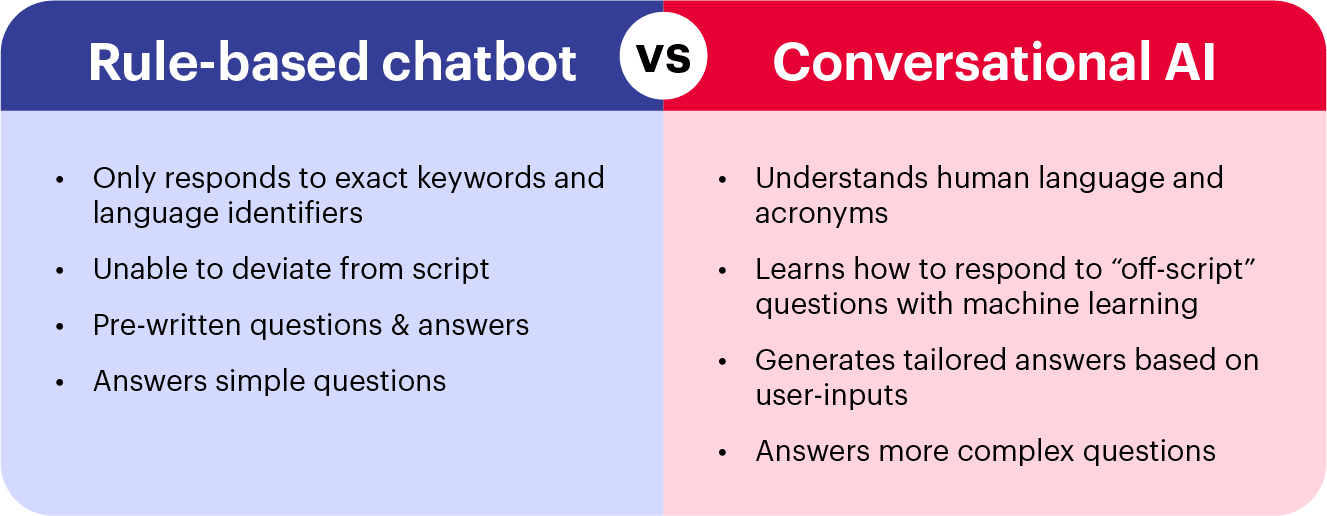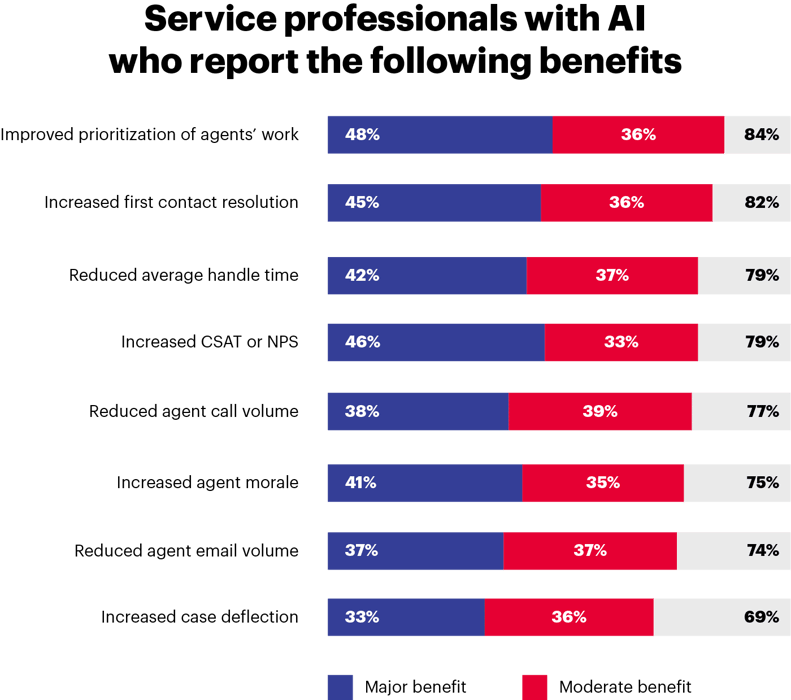In today's fast-paced digital landscape, businesses are navigating a complex web of customer expectations. Gone are the days when a simple FAQ page or automated email was enough to keep customers satisfied. Modern consumers expect immediate, personalised responses—whether they’re reaching out during business hours or in the middle of the night. Enter conversational AI, a transformative technology that’s reshaping how companies interact with their customers.
But what exactly is conversational AI, and why should businesses care? At its core, it’s an intelligent system that uses natural language processing (NLP) and machine learning (ML) to simulate human conversation. It’s the reason why some companies can now offer seamless, 24/7 support without sacrificing quality or efficiency. Whether it’s resolving customer issues in real time, boosting sales through personalised recommendations or streamlining operations by handling high volumes of queries, conversational AI has moved beyond the realm of futuristic tech and firmly into the business mainstream.
In this guide, we’ll explore how conversational AI works, what sets it apart from traditional chatbots and how your business can leverage its power to stay competitive in an increasingly customer-centric world. Whether you're just starting your journey into AI or looking to refine your current strategy, this blog will give you the insights and tools to make informed decisions about the future of customer engagement.
What is conversational AI?
Conversational AI is a type of artificial intelligence that powers interactions between humans and machines. By processing language through NLP, it interprets intent and responds naturally—whether the medium is text, voice or even video. Unlike traditional bots, conversational AI isn’t bound by a script; it adapts, learns and provides a human-like experience. As businesses increasingly turn to automation for efficiency and customer experience, conversational AI stands at the forefront of this transformation.

Source: Conversational AI vs. Chatbots: What's the Difference? - Capacity
How does conversational AI work
At its core, conversational AI is a sophisticated blend of technologies designed to understand, process and respond to human language. It’s not just about generating pre-written responses; it’s about creating dynamic, intelligent interactions that feel natural. The power behind conversational AI lies in two key components: natural language processing (NLP) and machine learning (ML).
NLP is the technology that enables computers to comprehend human language—both written and spoken. But it’s not just about understanding words; it’s about understanding meaning, intent and context. NLP works by breaking down language into smaller components—such as syntax and semantics—so that the AI can interpret what’s being said, much like a human would. It can distinguish between different tones, detect emotions and even identify key pieces of information in complex sentences. This allows the AI to accurately understand not just what users are asking, but why they’re asking it.
ML is what gives conversational AI its intelligence. Instead of relying solely on pre-programmed responses, ML allows the system to learn from each interaction, improving over time. When the AI receives a query, it processes it using NLP and searches its database of past conversations, relevant data and knowledge sources to craft the most accurate and contextually appropriate response. Each time it interacts with a user, it learns from that interaction, getting better at predicting the next response, refining its understanding of language and even personalising its replies based on past behaviour.
Additionally, conversational AI systems often integrate automatic speech recognition (ASR) and text-to-speech (TTS) technologies for voice-based interactions. ASR converts spoken words into text, enabling the AI to process voice commands, while TTS translates text responses into natural-sounding speech. Together, these technologies power voice assistants like Siri and Alexa, creating a smooth, human-like conversational flow.
Traditional chatbots vs. conversational AI: what sets them apart
Let’s clear up a common misconception: not all bots are created equal. Traditional chatbots are limited in scope—they follow a set of rules and can only provide answers that have been scripted for them. This often leads to frustrating dead ends for users who ask anything even slightly out of the ordinary. In contrast, conversational AI evolves with every interaction. Powered by advanced machine learning, it understands the nuances of human language and responds accordingly. The difference? Conversational AI feels more like talking to a knowledgeable assistant, while traditional chatbots often feel like, well, robots.
Types of conversational AI
Conversational AI is not a one-size-fits-all solution. Its flexibility and adaptability make it useful in various business contexts, with different types serving distinct purposes. Let’s break down some of the most prevalent forms of conversational AI, each tailored to specific needs:
Generative AI agents
Generative AI agents are among the most advanced forms of conversational AI. They leverage large language models (LLMs), such as GPT, to generate natural, engaging responses in real time. Unlike rule-based systems, generative AI doesn’t rely on predefined scripts. Instead, it interprets the intent of the user and crafts responses based on its deep knowledge base. This makes it ideal for handling open-ended, complex conversations that don’t follow a predictable path. For example, generative AI can be used in customer service to handle nuanced queries, recommend products or even manage conversational flows in sales.
Virtual assistants
Virtual assistants, such as Amazon’s Alexa or Apple’s Siri, are perhaps the most familiar type of conversational AI. These systems are primarily voice-activated and can be found in smartphones, smart speakers and even cars. Their primary function is to assist users with everyday tasks like scheduling appointments, answering queries and controlling smart home devices.
What sets virtual assistants apart is their ability to seamlessly interact with various applications and hardware, making them invaluable in both personal and business contexts. They act as intermediaries between the user and the digital world, responding to voice commands, delivering real-time information, and even learning user preferences over time.
Speech-to-text and text-to-speech AI
These AI systems specialise in converting spoken language into text and vice versa, which is critical for a wide range of applications. ASR technology enables machines to understand spoken language, transcribing it into text that can be processed and analysed. TTS technology, on the other hand, allows machines to ‘speak’ by converting written text into natural-sounding speech.
This type of AI plays a key role in accessibility, particularly for users who have visual or auditory impairments. It also enhances customer experiences by making interactions more flexible—allowing users to switch between text and voice inputs effortlessly. In call centres, for instance, speech-to-text technology helps transcribe customer conversations in real time, making it easier for agents to follow up on complex queries.
AI-driven customer support systems
AI-driven customer support systems are transforming contact centres worldwide. These systems can handle vast volumes of customer enquiries across multiple channels, including voice, email, chat and social media. By automating Tier-1 support tasks—such as answering frequently asked questions, troubleshooting basic issues and routing enquiries to the right department—AI-driven support frees up human agents to focus on more complex, high-value tasks.
What makes AI-driven customer support systems particularly powerful is their ability to provide consistent, high-quality responses while adhering to company policies. With machine learning capabilities, these systems continually refine their approach, ensuring that the quality of interactions improves over time. For businesses looking to scale their customer support operations without compromising service, AI-driven systems are a game-changer.
Benefits of conversational AI in business
The advantages of conversational AI go far beyond simple cost savings. When deployed strategically, it has the potential to revolutionise how businesses operate, offering both immediate and long-term value. Let’s explore the key benefits in more detail:
-
Enhance customer service
With 24/7 availability, conversational AI ensures customers get immediate support, reducing wait times and frustration. It handles basic queries instantly, freeing up human agents for more complex tasks, which improves overall customer satisfaction and brand loyalty.
-
Increased efficiency
AI can manage thousands of interactions simultaneously, streamlining operations and reducing the load on human teams. By automating routine tasks, it boosts productivity and ensures no customer is left waiting.
-
Personalised experiences
Conversational AI uses data from past interactions to offer tailored responses and recommendations. This level of personalisation not only solves immediate issues but also enhances long-term customer relationships.
-
Consistent messaging
AI ensures that customers receive accurate and consistent information across all channels. Unlike human agents, AI follows brand guidelines to the letter, reducing errors and ensuring every interaction aligns with company policies.
-
Scalability
AI easily adapts to fluctuating demand, handling high volumes of interactions during peak times without compromising service. It can also be deployed across multiple channels, making it ideal for businesses looking to grow and scale efficiently.
Steps to get started with conversational AI
Implementing conversational AI can be transformative for your business, but it requires a clear strategy. Follow these steps to get started effectively:
-
Understand the problem you want to solve
Before diving into conversational AI, it's critical to define your goals. Are you looking to reduce operational costs, improve customer service, or drive sales? Understanding the specific problem you want AI to address will guide the entire implementation process. For example, if your customer service team is overwhelmed with repetitive enquiries, AI can automate those tasks, freeing up agents for more complex issues. Defining clear objectives early on ensures your AI strategy aligns with your business needs.

Source: Conversational AI Statistics: State of Chatbots in 2020 | Landbot
-
Identify where agents spend most of their time
Analyse your current customer service operations to find out where conversational AI can make the biggest impact. Review call logs, chat transcripts and other customer interaction data to see which types of queries consume the most agent time. Are they frequently answering the same questions, or are they spending time on simple, repetitive tasks? Once you identify these high-frequency interactions, you can target them for automation with AI, improving efficiency and allowing agents to focus on higher-value tasks.
-
Mock up a vision of what conversational AI could deliver
To get buy-in from key stakeholders, it’s essential to create a clear vision of how conversational AI will benefit your organisation. This could be a roadmap or a mock-up that demonstrates potential use cases, expected outcomes and the long-term value AI will bring. Keep it simple but informative. Visual aids such as flowcharts or before-and-after comparisons can help illustrate how AI will streamline processes, improve customer satisfaction and ultimately drive business growth. This vision will not only align stakeholders but also provide a reference point throughout the implementation process.
-
Find the right tools
Selecting the right conversational AI platform is crucial for a successful deployment. Look for tools that integrate seamlessly with existing technology infrastructure to avoid disruptions. Many AI platforms, like Convai’s Oration, are designed to layer over existing systems, making it easier to implement without a complete overhaul. You’ll also want to consider the tool’s ability to scale, its ease of customisation, and whether it offers support for multiple languages or channels. The right solution should be flexible enough to grow with your business and adaptable to evolving customer needs.
How to choose a conversational AI partner
Selecting the right conversational AI partner is crucial to ensuring a successful implementation and long-term value for your business. With many providers offering different levels of service, features and flexibility, it’s essential to make an informed decision. Here’s what to look for when choosing your AI partner:
Ease of integration
A top priority when choosing a conversational AI partner is seamless integration with your existing systems. The best solutions will work within your current infrastructure—whether that’s your CRM, contact centre platform or eCommerce system—without requiring a complete overhaul. This minimises disruption to your operations and allows for a faster deployment. An ideal partner will offer APIs or connectors that make integrating their AI with your existing workflows simple and efficient. This ensures that you can start seeing results quickly without getting bogged down in technical complexities.
Customisation
Your business has unique needs, and your conversational AI solution should be adaptable to those requirements. Look for a provider that offers robust customisation options—whether it’s tailoring the AI to handle specific customer service tasks, automating sales enquiries or solving technical troubleshooting issues. The AI should be flexible enough to adjust to your business’s evolving needs, allowing you to scale its capabilities as you grow. An effective partner will offer a solution that can be fine-tuned to your industry, customer base and specific operational challenges, rather than a one-size-fits-all approach.
Ongoing support and training
Implementation is just the beginning. Your conversational AI partner should provide continuous support and training to ensure the system performs optimally over time. As AI systems learn and evolve, regular updates and improvements are necessary to maintain high levels of accuracy and efficiency. A strong partner will offer dedicated customer service, comprehensive training for your team and proactive updates to the AI’s functionality. For instance, Convai’s Oration solution provides not only a quick, plug-and-play deployment but also ongoing support that ensures the AI evolves with your business, continuously delivering value.
Scalability and future-proofing
Your business’s needs will change, and the conversational AI you choose should be able to scale alongside your growth. A good partner will offer a solution that can handle increasing volumes of customer interactions without sacrificing performance. Whether you're expanding into new markets, introducing new languages or adding more customer touchpoints (such as social media or voice), the AI should be able to adapt. Future-proofing is key here—ensure the solution can be upgraded with new features and advancements in AI technology, so your investment remains valuable for years to come.
Proven success and industry expertise
It’s essential to work with a conversational AI partner that has proven success in your industry. Look for case studies, testimonials or references that showcase how the provider has helped other businesses in similar sectors achieve measurable results. Industry expertise ensures that the AI is designed with your specific challenges in mind—whether that’s compliance, customer behaviour patterns or regional regulations. Choosing a partner with a strong track record reduces risks and increases the likelihood of a smooth, impactful implementation.
Find seamless tools that can accelerate the vision
Befitting a competitive sector, there are an endless array of conversational AI tools in the market but the vast majority require complex skill sets possessed by difficult-to-recruit experts. Needless to say, that combination typically results in more costly projects that take longer to implement.
A far smarter approach is to search for ready-to-use solutions that do not require contact centres to start from scratch or reinvent the wheel. Conversational AI tools such as Oration by Convai can be implemented over the top of existing technology infrastructure, which means users can configure its features to their needs without or without the providers’ help, accelerate their speed to market and allow them to continuously innovate.
The digital boom has resulted in a staggering increase in victims of identity theft and cybercrime. Learn why customer authentication has become one of the highest priorities for businesses and the people they serve.
Updated November 2024





